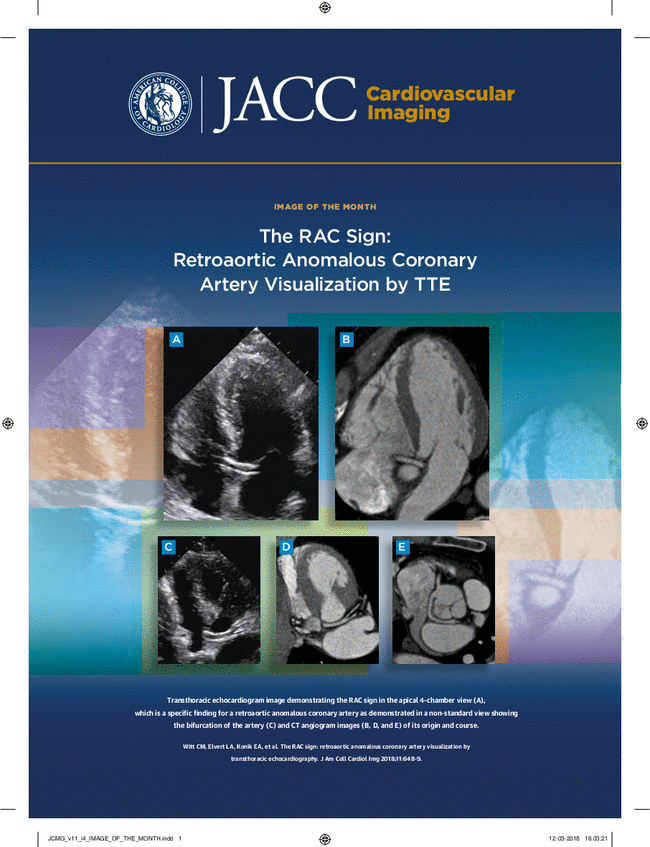中重度主动脉反流患者心脏不良重构的分期分析。
IF 15.2
1区 医学
Q1 CARDIAC & CARDIOVASCULAR SYSTEMS
引用次数: 0
摘要
背景:最近提出的心脏结构和功能异常的分期系统显示了主动脉狭窄的增量预后价值。目的:作者研究一种结合心脏磁共振(CMR)的中度或重度主动脉瓣反流(AR)分期系统。方法:前瞻性入选DeBakey - cmr (DeBakey心血管磁共振研究;NCT04281823)在2009年至2020年期间通过CMR进行中度或重度AR研究。我们排除了原发性心肌病(如肥厚性心肌病、淀粉样变性、结节病)或既往瓣膜干预的患者。分期定义为0期:无心脏重构;第一阶段:左室重构;2期:二尖瓣或左房异常;第三阶段,右心脏重塑。结果是全因死亡率。结果:作者研究了395例患者,中位年龄62岁(Q1-Q3: 51-72岁);79.2%为男性,25.8%为双尖瓣主动脉瓣。0期32例(8.10%),1期146例(37.0%),2期77例(19.5%),3期140例(35.4%)。在平均3.9±2.9年的随访期间,0期的年化死亡率为0.68% /年,1期为2.25% /年,2期为3.76% /年,3期为7.25% /年(死亡率趋势P)。结论:结合CMR结果的心脏重构分期系统在调整手术风险、AVR和反流严重程度后,可增加AR的预后。AR右心重构与最高死亡率相关。进一步的研究可以确定分期系统是否可以帮助指导患者管理和干预的时机。本文章由计算机程序翻译,如有差异,请以英文原文为准。
Staging of Cardiac Adverse Remodeling in Moderate or Severe Aortic Regurgitation
Background
A recently proposed staging system for cardiac structural and functional abnormalities demonstrated incremental prognostic value in aortic stenosis.
Objectives
The authors investigate a staging system incorporating cardiac magnetic resonance (CMR) in moderate or severe aortic regurgitation (AR).
Methods
Patients prospectively enrolled in DEBAKEY-CMR (DeBakey Cardiovascular Magnetic Resonance Study; NCT04281823) between 2009 and 2020 who had moderate or severe AR by CMR were studied. We excluded patients with a primary cardiomyopathy (eg, hypertrophic cardiomyopathy, amyloidosis, sarcoidosis) or prior valve intervention. The stages were defined as stage 0: no cardiac remodeling; stage 1: left ventricular (LV) remodeling; stage 2: mitral valve or left atrial abnormalities; and stage 3: right heart remodeling. The outcome was all-cause mortality.
Results
The authors studied 395 patients, median age 62 years (Q1-Q3: 51-72 years); 79.2% were male, and 25.8% had bicuspid aortic valve. Thirty-two patients (8.10%) were classified as stage 0, 146 (37.0%) as stage 1, 77 (19.5%) as stage 2, and 140 (35.4%) as stage 3. Over a mean follow-up period of 3.9 ± 2.9 years, the annualized mortality rate was 0.68% per year in stage 0, 2.25% per year in stage 1, 3.76% per year in stage 2, and 7.25% per year in stage 3 (P for trend of mortality <0.001). The extent of cardiac remodeling was independently associated with increased hazard for mortality (adjusted HR: 1.69 per increment of stage [95% CI: 1.28-2.23]; P < 0.001) after adjusting for regurgitation severity, aortic valve replacement (AVR), and EuroSCORE II (European System for Cardiac Operative Risk Evaluation). Patients with right heart remodeling had the highest hazard for events.
Conclusions
A cardiac remodeling staging system incorporating CMR findings provides incremental prognostication in AR after adjusting for surgical risk, AVR, and regurgitation severity. Right heart remodeling in AR was associated with the highest mortality. Further research can determine whether the staging system could aid in guiding patient management and the timing of intervention.
求助全文
通过发布文献求助,成功后即可免费获取论文全文。
去求助
来源期刊

JACC. Cardiovascular imaging
CARDIAC & CARDIOVASCULAR SYSTEMS-RADIOLOGY, NUCLEAR MEDICINE & MEDICAL IMAGING
CiteScore
24.90
自引率
5.70%
发文量
330
审稿时长
4-8 weeks
期刊介绍:
JACC: Cardiovascular Imaging, part of the prestigious Journal of the American College of Cardiology (JACC) family, offers readers a comprehensive perspective on all aspects of cardiovascular imaging. This specialist journal covers original clinical research on both non-invasive and invasive imaging techniques, including echocardiography, CT, CMR, nuclear, optical imaging, and cine-angiography.
JACC. Cardiovascular imaging highlights advances in basic science and molecular imaging that are expected to significantly impact clinical practice in the next decade. This influence encompasses improvements in diagnostic performance, enhanced understanding of the pathogenetic basis of diseases, and advancements in therapy.
In addition to cutting-edge research,the content of JACC: Cardiovascular Imaging emphasizes practical aspects for the practicing cardiologist, including advocacy and practice management.The journal also features state-of-the-art reviews, ensuring a well-rounded and insightful resource for professionals in the field of cardiovascular imaging.
 求助内容:
求助内容: 应助结果提醒方式:
应助结果提醒方式:


